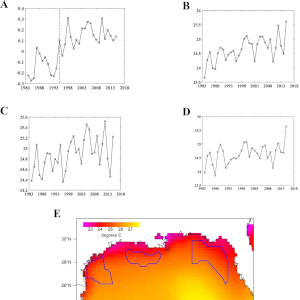The Gulf of Mexico is an ecologically and economically important marine ecosystem that is affected by a variety of natural and anthropogenic pressures. These complex and interacting pressures, together with the dynamic environment of the Gulf, present challenges for the effective management of its resources. The recent adoption of Bayesian networks to ecology allows for the discovery and quantification of complex interactions from data after making only a few assumptions about observations of the system. In this study, we apply Bayesian network models, with different levels of structural complexity and a varying number of hidden variables to account for uncertainty when modeling ecosystem dynamics. From these models, we predict focal ecosystem components within the Gulf of Mexico. The predictive ability of the models varied with their structure. The model that performed best was parameterized through data-driven learning techniques and accounted for multiple ecosystem components’ associations and their interactions with human and natural pressures over time. Then, we altered sea surface temperature in the best performing model to explore the response of different ecosystem components to increased temperature. The magnitude and even direction of predicted responses varied by ecosystem components due to heterogeneity in driving factors and their spatial overlap. Our findings suggest that due to varying components’ sensitivity to drivers, changes in temperature will potentially lead to trade-offs in terms of population productivity. We were able to discover meaningful interactions between ecosystem components and their environment and show how sensitive these relationships are to climate perturbations, which increases our understanding of the potential future response of the system to increasing temperature. Our findings demonstrate that accounting for additional sources of variation, by incorporating multiple interactions and pressures in the model layout, has the potential for gaining deeper insights into the structure and dynamics of ecosystems.
Predicting ecosystem components in the Gulf of Mexico and their responses to climate variability with a dynamic Bayesian network model
Publication date
January 23, 2019
Abstract
Journal
PLOS ONE
Region
Gulf of America


